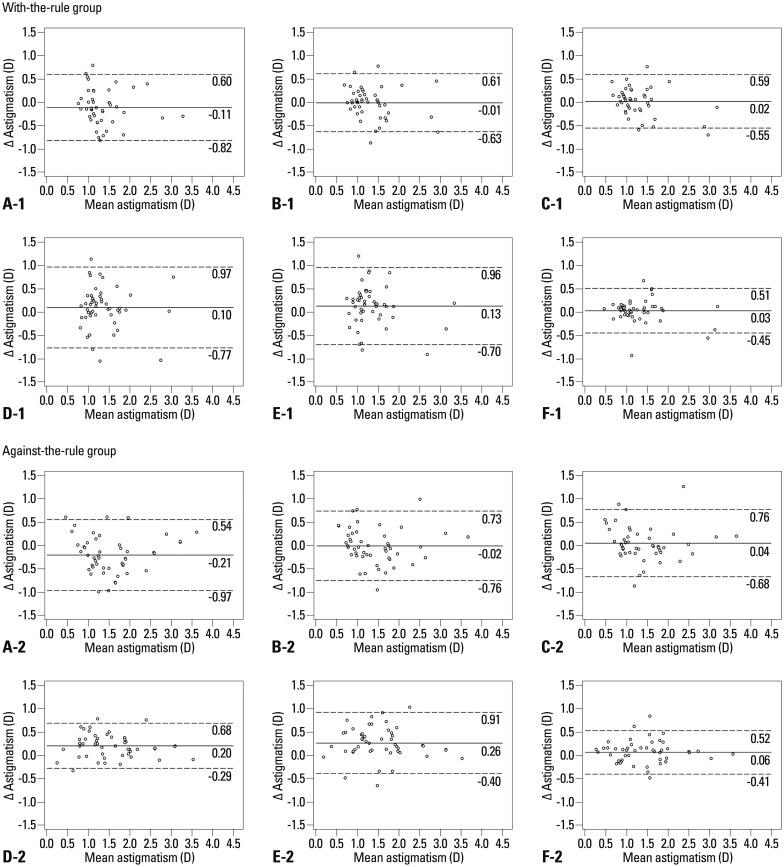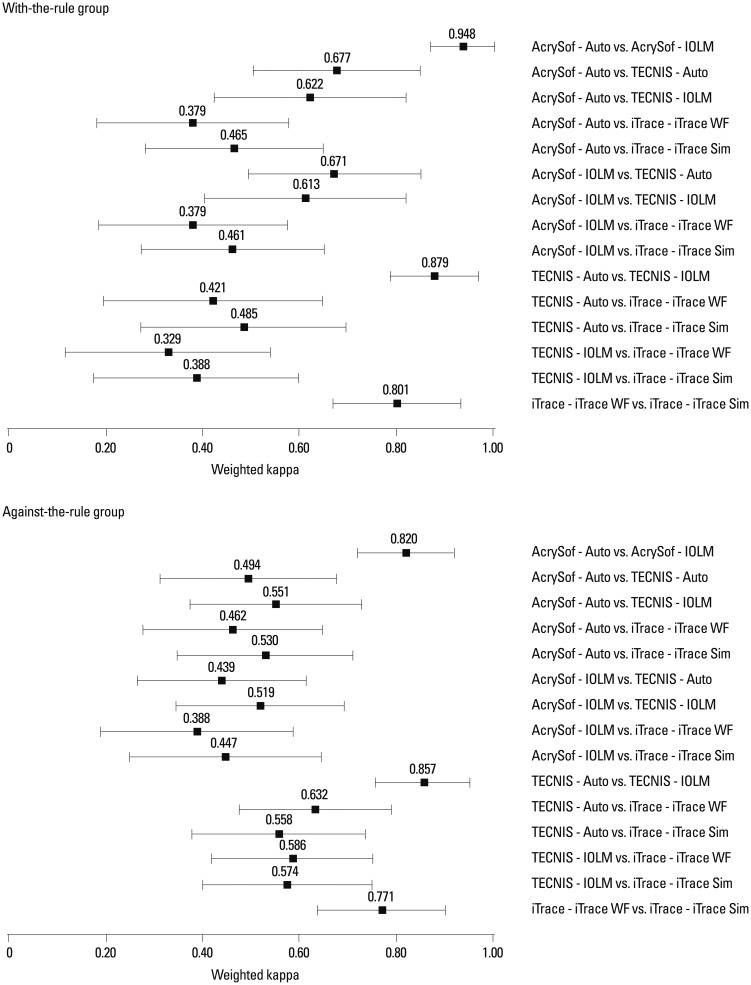Yonsei Med J.
2015 Jul;56(4):1097-1105. 10.3349/ymj.2015.56.4.1097.
Comparison of the Astigmatic Power of Toric Intraocular Lenses Using Three Toric Calculators
- Affiliations
-
- 1The Institute of Vision Research, Department of Ophthalmology, Yonsei University College of Medicine, Seoul, Korea. tikim@yuhs.ac
- 2Department of Ophthalmology, International St. Mary's Hospital, Catholic Kwandong University College of Medicine, Incheon, Korea.
- 3Cornea Dystrophy Research Institute, Department of Ophthalmology, Severance Biomedical Science Institute, and Brain Korea 21 Project for Medical Science, Yonsei University College of Medicine, Seoul, Korea.
- 4Biostatistics Collaboration Unit, Yonsei University College of Medicine, Seoul, Korea.
- KMID: 2366353
- DOI: http://doi.org/10.3349/ymj.2015.56.4.1097
Abstract
- PURPOSE
To compare the astigmatic power of toric intraocular lenses (IOLs) obtained from the AcrySof, TECNIS, and iTrace toric calculator in patients with preoperative with-the-rule (WTR) or against-the-rule (ATR) corneal astigmatism.
MATERIALS AND METHODS
Fifty eyes with cataract and corneal astigmatism greater than 0.75 diopters were enrolled in each group (WTR and ATR). Keratometric values were measured using autokeratometry, an IOLMaster, and an iTrace, which incorporated corneal topography and ray-tracing aberrometry. Based on measured keratometric values, the astigmatic power of each toric IOL was calculated using three toric calculators.
RESULTS
Bland-Altman plots showed good agreement between six pairwise corneal astigmatism values in both groups. The TECNIS calculator tended to suggest a higher astigmatic power of the toric IOL than the AcrySof calculator. With the higher astigmatism and keratometric values from the IOLMaster, in both groups, calculations from the AcrySof and TECNIS calculators resulted in higher calculated astigmatic powers than those from same calculators with autokeratometry-measured values, demonstrating good agreement. With the higher calculated astigmatic power values, the values from the iTrace toric calculator using keratometric values obtained from iTrace ray tracing wavefront aberrometry or iTrace simulated keratometry showed fair to moderate agreement with those from the other calculator-keratometry pairs in both groups.
CONCLUSION
To achieve the best refractive outcome after toric IOL implantation, understanding the differences in keratometric values between instruments and in calculated astigmatic power among toric calculator programs is necessary. Moreover, systemic analysis of each toric calculator in conjunction with postoperative data is required.
MeSH Terms
Figure
Reference
-
1. Hoffer KJ. Biometry of 7,500 cataractous eyes. Am J Ophthalmol. 1980; 90:360–368. PMID: 7425052.
Article2. Hoffmann PC, Hütz WW. Analysis of biometry and prevalence data for corneal astigmatism in 23,239 eyes. J Cataract Refract Surg. 2010; 36:1479–1485. PMID: 20692558.3. Ferrer-Blasco T, Montés-Micó R, Peixoto-de-Matos SC, González-Méijome JM, Cerviño A. Prevalence of corneal astigmatism before cataract surgery. J Cataract Refract Surg. 2009; 35:70–75. PMID: 19101427.
Article4. Wolffsohn JS, Bhogal G, Shah S. Effect of uncorrected astigmatism on vision. J Cataract Refract Surg. 2011; 37:454–460. PMID: 21333869.
Article5. Visser N, Bauer NJ, Nuijts RM. Residual astigmatism following toric intraocular lens implantation related to pupil size. J Refract Surg. 2012; 28:729–732. PMID: 22978297.
Article6. Guo H, Atchison DA. Subjective blur limits for cylinder. Optom Vis Sci. 2010; 87:E549–E559. PMID: 20562670.
Article7. Hayashi K, Kondo H, Yoshida M, Manabe S, Hirata A. Higher-order aberrations and visual function in pseudophakic eyes with a toric intraocular lens. J Cataract Refract Surg. 2012; 38:1156–1165. PMID: 22608030.
Article8. Scialdone A, Raimondi G, Monaco G. In vivo assessment of higher-order aberrations after AcrySof toric intraocular lens implantation: a comparative study. Eur J Ophthalmol. 2012; 22:531–540. PMID: 22139617.
Article9. Savini G, Barboni P, Parisi V, Carbonelli M. The influence of axial length on retinal nerve fibre layer thickness and optic-disc size measurements by spectral-domain OCT. Br J Ophthalmol. 2012; 96:57–61. PMID: 21349942.
Article10. Ernest P, Potvin R. Effects of preoperative corneal astigmatism orientation on results with a low-cylinder-power toric intraocular lens. J Cataract Refract Surg. 2011; 37:727–732. PMID: 21333485.
Article11. Shirayama M, Wang L, Weikert MP, Koch DD. Comparison of corneal powers obtained from 4 different devices. Am J Ophthalmol. 2009; 148:528–535. PMID: 19541287.
Article12. Lee H, Chung JL, Kim EK, Sgrignoli B, Kim TI. Univariate and bivariate polar value analysis of corneal astigmatism measurements obtained with 6 instruments. J Cataract Refract Surg. 2012; 38:1608–1615. PMID: 22795977.
Article13. Wang Q, Savini G, Hoffer KJ, Xu Z, Feng Y, Wen D, et al. A comprehensive assessment of the precision and agreement of anterior corneal power measurements obtained using 8 different devices. PLoS One. 2012; 7:e45607. PMID: 23049823.
Article14. Landis JR, Koch GG. The measurement of observer agreement for categorical data. Biometrics. 1977; 33:159–174. PMID: 843571.
Article15. Chen W, Zuo C, Chen C, Su J, Luo L, Congdon N, et al. Prevalence of corneal astigmatism before cataract surgery in Chinese patients. J Cataract Refract Surg. 2013; 39:188–192. PMID: 23141077.
Article16. Visser N, Bauer NJ, Nuijts RM. Toric intraocular lenses: historical overview, patient selection, IOL calculation, surgical techniques, clinical outcomes, and complications. J Cataract Refract Surg. 2013; 39:624–637. PMID: 23522584.
Article
- Full Text Links
- Actions
-
Cited
- CITED
-
- Close
- Share
- Similar articles
-
- The Effect of Astigmatism Correction in Myopic Astigmatism by Toric Lenses: Comparison with Hard Contact Lenses
- Scleral Fixation of a Single-Piece AcrySof Toric Intraocular Lens: A Case Report
- Comparison of Efficacies in Treating Astigmatism between Toric Intraocular Lens Implantation and Limbal Relaxing Incision
- The Efficacy of KR-1W Aberrometer in Assessing the Astigmatism after Toric Intraocular Lens Implantation
- Comparison of Refractive Power and Astigmatism between Digital Keratometer and Autorefractor



